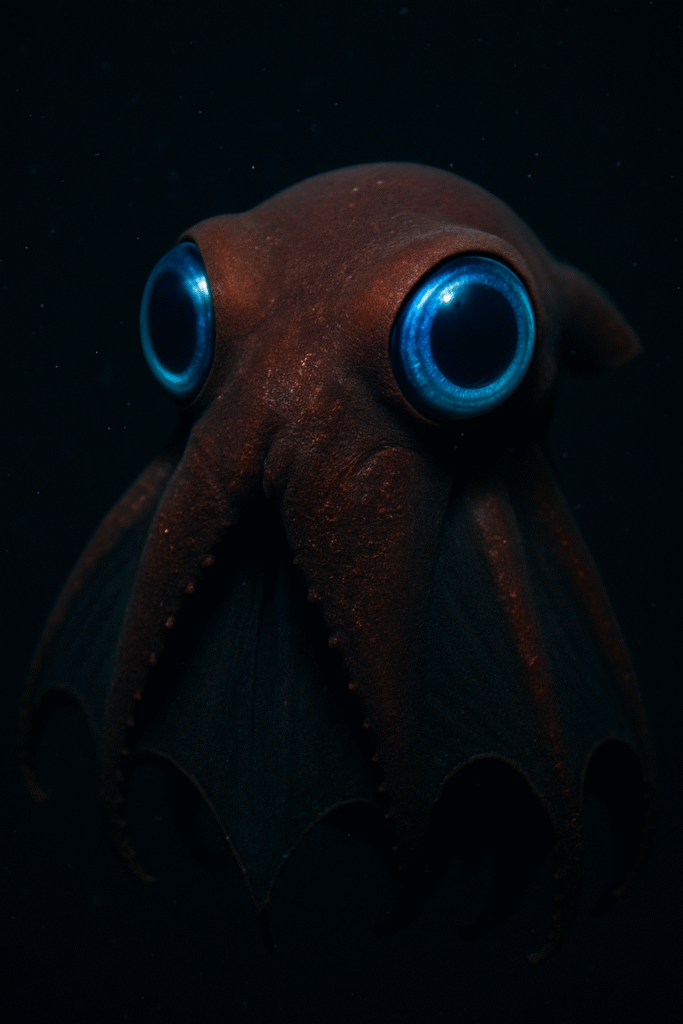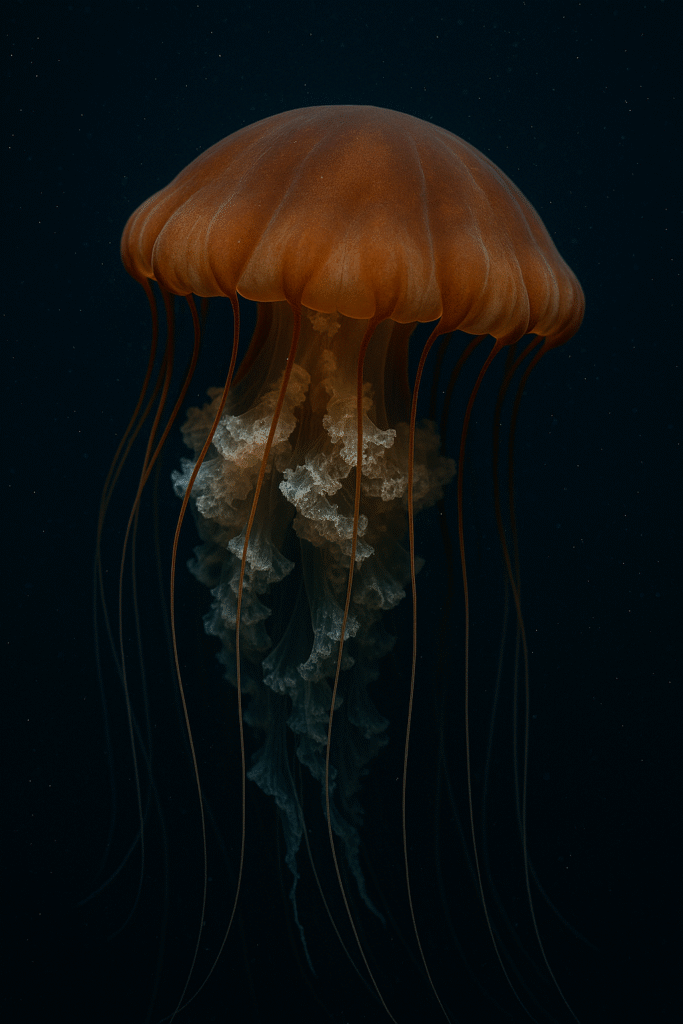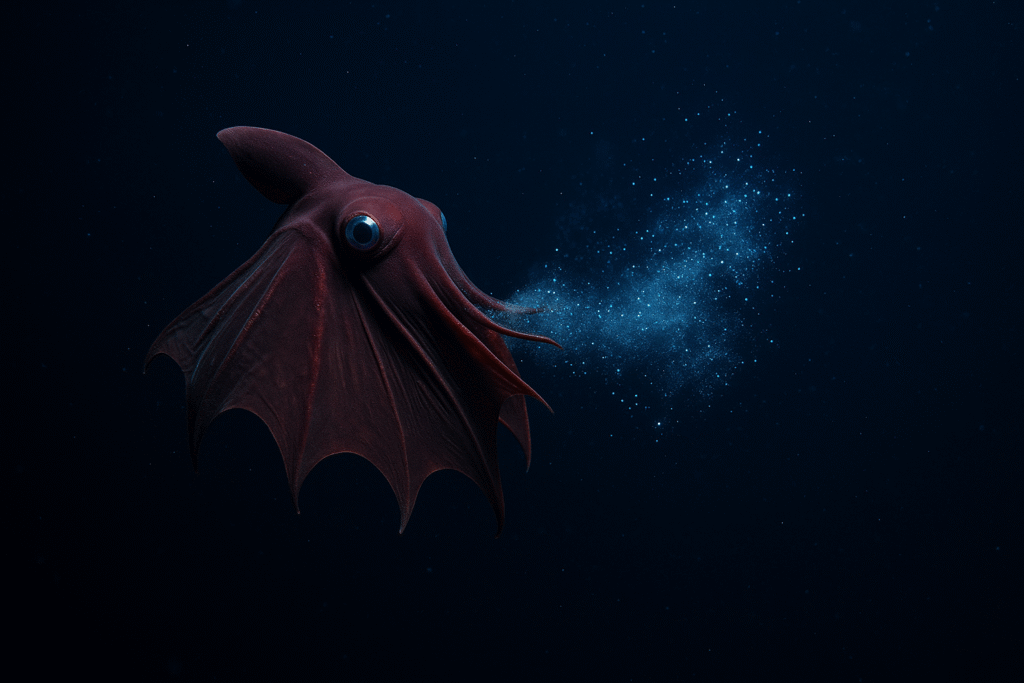In the blackest reaches of the world’s oceans, far below the last kiss of sunlight, there exists a creature that has long captured human imagination and dread: the vampire squid (Vampyroteuthis infernalis). Its name, which translates ominously as “vampire squid from hell”, suggests a predator worthy of nightmares. But names, like shadows, can mislead. This small, delicate cephalopod is not a monster of the abyss but a quiet drifter, a living relic of prehistory, and a symbol of survival against all odds.

The vampire squid’s story is not one of terror, but of endurance. It has persisted for over 300 million years, surviving multiple mass extinctions, enduring pressures that would crush submarines, and thriving in waters nearly devoid of oxygen. To study the vampire squid is to peer not only into the mysteries of the deep but also into the resilience of life itself.
A Creature Out of Deep Time
The vampire squid is unique among cephalopods. While modern squids and octopuses evolved in separate directions, the vampire squid represents a lineage frozen in evolutionary time, retaining traits of both but belonging fully to neither. Scientists call it a “living fossil,” a phrase that understates its significance. It is a link to an ancient ocean, carrying in its gelatinous body the memory of a world that existed long before mammals—or even dinosaurs—walked the Earth.
It is small—rarely longer than 30 centimeters—but it does not need grandeur of size. Its survival has come not from dominance, but from adaptation.
Anatomy of a Phantom
At first glance, the vampire squid’s appearance can be unsettling. Its arms are connected by a cloak of black webbing, creating a silhouette reminiscent of a bat unfurling its wings. Along those arms lie rows of fleshy cirri—soft, spine-like projections that look fearsome but pose no threat.
Its eyes are enormous, proportionally larger than those of any other animal on Earth relative to body size. In the deep sea, where photons are rare and faint, this adaptation allows the vampire squid to detect the tiniest glimmers of bioluminescence. Some specimens have eyes that appear sapphire blue, others blood red, depending on how light refracts in their tissues—adding to their eerie allure.
Instead of ink, which would be invisible in its dark realm, the vampire squid has evolved bioluminescent defenses. When threatened, it ejects glowing clouds of mucus filled with blue-green sparks, a dazzling confusion display that can persist for minutes, long enough for its fragile body to drift into safety.
Feeding on Snow
Unlike its fearsome name, the vampire squid is no predator of blood. It is a collector of dust in the sea.
In the ocean, particles of decaying plants, animal remains, plankton, and fecal matter constantly drift downwards, forming a slow, eternal rain known as marine snow. For most creatures, this detritus is waste. For the vampire squid, it is sustenance.
Using two long, retractable filaments—rare among cephalopods—it reaches out to gather this snow, drawing it into sticky strands, then rolling it into nutrient-rich balls. It consumes these with care, thriving in a place where larger predators cannot. In this way, the vampire squid plays a quiet but crucial role: it recycles the ocean’s cast-offs, keeping energy flowing even in the most barren depths.
Life in the Oxygen Minimum Zone
The vampire squid occupies a zone few others can tolerate: the oxygen minimum zone (OMZ), between 600 and 1,200 meters deep. Here, oxygen levels are less than 3 percent of those at the surface—lethal to most fish and squids.
But the vampire squid has evolved a metabolism so slow that it can survive with almost no oxygen. Its blood contains a form of hemocyanin (the copper-based molecule that transports oxygen in cephalopods) uniquely adapted to bind oxygen efficiently in these depleted conditions. Its soft, gelatinous body floats with little effort, conserving energy. In the OMZ, it is free of most predators, inhabiting a kingdom of silence and scarcity where others cannot follow.
Cloak of Shadows
When threatened, the vampire squid employs one of the most dramatic defenses in the animal kingdom: the “pineapple posture.” It inverts its cloak-like web, pulling its arms up over its body to expose the cirri and spiny textures inside. To a predator, the once-smooth drifter becomes an unappetizing, alien silhouette.

If this does not deter, it unleashes its bioluminescent fireworks—a luminous smokescreen of glowing particles drifting like stars. It is a strategy of illusion, not violence. The vampire squid cannot fight back, so it survives by bewildering, by vanishing into the dark as if it had never been there.
Myths, Names, and Misconceptions
When the vampire squid was first described in the early 20th century, its name—Vampyroteuthis infernalis—was chosen more for drama than for accuracy. Sailors already spoke of monsters in the deep, and the cephalopod’s bat-like appearance lent itself to stories of demons from below.
But the truth could not be further. This animal does not hunt whales or bleed the living. Instead, it is one of the ocean’s most peaceful recyclers, a cleaner of the deep. The “vampire” in its name reveals more about human fear of the unknown than about the creature itself.
The Philosophy of the Abyss
In the vampire squid we find a paradox: an animal named for terror, yet defined by restraint. It lives not by conquest, but by patience. It does not consume the living, but the forgotten. Its survival has never depended on aggression, but on the ability to endure quietly where others cannot.
This makes the vampire squid a symbol—not of monsters, but of misunderstood resilience. It challenges our idea that only strength, speed, or ferocity ensures survival. Sometimes, it is the drifter, the recycler, the quiet one who outlives all rivals.
Threats in a Changing Ocean
Although the vampire squid lives far beyond the reach of most fisheries, it is not immune to human influence. Climate change is altering deep-sea oxygen levels, expanding OMZs but also changing nutrient flows that sustain marine snow. Plastic pollution, now found even in the abyss, tangles in food webs that were once pristine.
As we extend human activity deeper into the ocean—through mining, drilling, and waste—the fragile kingdom of the vampire squid may not remain untouched. It is a reminder that no depth is beyond our reach, and no life form beyond our responsibility.
Legacy of Darkness
The vampire squid has survived longer than empires, longer than continents in their current form, longer than many species that once ruled the world. It is a survivor of extinctions, a ghost of ancient oceans, and a gardener of the deep.

To see it drifting, cloak unfurled, glowing sparks trailing in the water, is to glimpse the poetry of endurance. Life persists not only through power, but through humility, mystery, and adaptation.
The vampire squid is not from hell—it is from history. It is the ocean’s whisper: that the greatest survival stories are not always the loudest, but the ones that pass quietly, unseen, for millions of years.


Reply